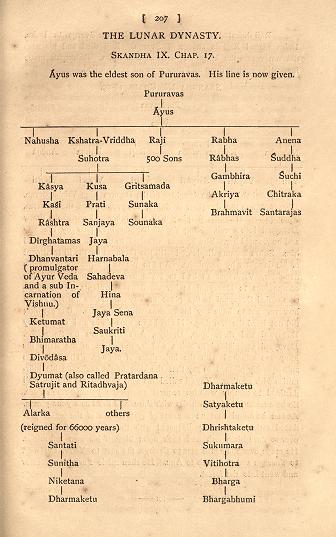Nahusha


Nahusha (नहुष) or Nahush (नहुष) was son of Ayu, the eldest of Pururavas, and father of Yayati. This king is mentioned by Manu as having come into conflict with the Brahmans, and his story is repeated several times with variations in different parts of the Mahabharata as well as in the Puranas. According to Manu "By sacrifices, austere fervour, sacred study, self-restraint, and valour, Nahusha acquired the undisturbed sovereignty of the three worlds. Through want of virtuous humility the great king Nahusha was utterly ruined".
One version of the story says that he aspired to the possession of Indrani, wife of Indra, when that god had concealed himself for having killed a Brahman. A thousand great Rishis bore the car of Nahusha through the air, and on one occasion he touched with his foot the great Agastya, who carrying him. The sage in his anger cried out, "Fall, thy serpent," and Nahusha fell from his glorious car and became a serpent.
Agastya, at the supplication of Nahusha, put a limit to the curse; and according to one version, the doomed man was released from it by the instrumentality of Yudhisthira, when he threw off "his huge reptile form, became clothed in a celestial body, and ascended to heaven."
Sister Nivedita also has mentioned about the king Nahusa in one story "The Worth of Kine" in relation to rishi Chyavana who was caught in net while fishing in river by fishermen along with fish. The fishermen took the rishi Chyavana to king Nahusha and asked to pay the price of fish and the rishi. Nahusha offered a cow for Chyavana. [1]
Naga King Nahush
Nahush (नहुष) has also been mentioned as a Nagavanshi king in Naga rulers.
Jat descendant of Nahusha

- Neol (न्योल) Nyol (न्योळ) Nyol (न्योल) Nol (नोल) gotra Jats are considered to be the descendants of Nahusha. [2]
- Nuhania (नूहनियाँ) Nuhaniya (नूहनियाँ) gotra of Jats have originated from samrat named Nahusha (नहुष). [3]
- Nohar (नोहर) - Nohar gotra Jats are considered to be the descendants of Nahusha. [4]
खांडवप्रस्थ
विजयेन्द्र कुमार माथुर[5] ने लेख किया है कि....खांडवप्रस्थ (AS, p.255) हस्तिनापुर के पास एक प्राचीन नगर था जहां महाभारतकाल से पूर्व पुरुरवा, आयु, नहुष तथा ययाति की राजधानी थी. कुरु की यह प्राचीन राजधानी बुधपुत्र के लोभ के कारण मुनियों द्वारा नष्ट कर दी गई. युधिष्ठिर को, जब प्रारंभ में, द्यूत-क्रीडा से पूर्व, आधा राज्य मिला तो धृतराष्ट्र ने पांडवों से खांडवप्रस्थ में अपनी राजधानी बनाने तथा फिर से उस प्राचीन नगर को बसाने के लिए कहा था. (महाभारत आदि पर्व, 206 दक्षिणात्य पाठ) तत्पश्चात पांडवों ने खांडवप्रस्थ पहुंच कर उस प्राचीन नगर के स्थान पर एक घोर वन देखा. (आदि पर्व: 206, 26-27). खांडवप्रस्थ के स्थान पर ही इंद्रप्रस्थ नामक नया नगर बसाया गया जो भावी दिल्ली का केंद्र बना. खांडवप्रस्थ के निकट ही खांडववन स्थित था जिसे श्रीकृष्ण और अर्जुन ने अग्निदेव की प्रेरणा से भस्म कर दिया. खांडवप्रस्थ का उल्लेख अन्यत्र भी है. पंचविंशब्राह्मण 25,3,6 में राजा अभिप्रतारिन् के पुरोहित द्दति खांडवप्रस्थ में किए गए यज्ञ का उल्लेख है. अभिप्रतारिन् जनमेजय का वंशज था. जैसा पूर्व उद्धरणों से स्पष्ट है, खांडवप्रस्थ पांडवों के पुराने किले के निकट बसा हुआ था. (दे. इंद्रप्रस्थ, हस्तिनापुर)
References
- ↑ Sister Nivedita & Ananda K.Coomaraswamy: Myths and Legends of the Hindus and Bhuddhists, Kolkata, 2001 ISBN 81-7505-197-3
- ↑ Dr Mahendra Singh Arya, Dharmpal Singh Dudi, Kishan Singh Faujdar & Vijendra Singh Narwar: Ādhunik Jat Itihas (The modern history of Jats), Agra 1998
- ↑ Dr Mahendra Singh Arya, Dharmpal Singh Dudee, Kishan Singh Faujdar & Vijendra Singh Narwar: Ādhunik Jat Itihas (The modern history of Jats), Agra 1998, p. 260
- ↑ Dr Mahendra Singh Arya, Dharmpal Singh Dudi, Kishan Singh Faujdar & Vijendra Singh Narwar: Ādhunik Jat Itihas (The modern history of Jats), Agra 1998, p.261
- ↑ Aitihasik Sthanavali by Vijayendra Kumar Mathur, p.255
Dowson's Classical Dictionary of Hindu Mythology
Back to The Ancient Jats

